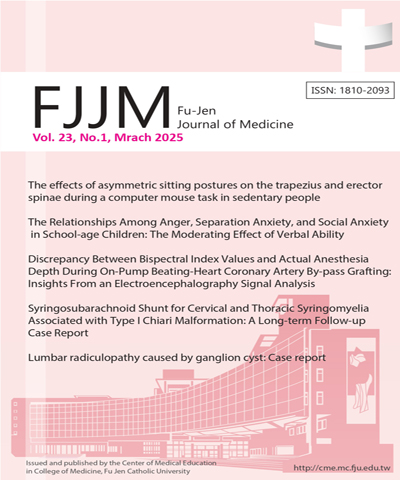
輔仁醫學期刊/Fu-Jen Journal of Medicine
輔仁大學醫學院,正常發行
選擇卷期
- 期刊
Introduction: The perforated gastroduodenal ulcer remains a challenge for surgeons even in the era of effective anti-ulcer medications. This study was performed to identify risk factors associated with early surgical morbidity and mortality of patients with perforated ulcers and how to improve the clinical outcomes. Methods: We retrospectively reviewed 444 patients who underwent operations for the perforated ulcers in a tertiary medical center located in central Taiwan between January 1, 1997 and December 31, 2002. Demographic data, intraoperative findings, surgical procedures, complications, and outcomes were analyzed. Statistical significance was attributed to p<0.05. Results: The mean age was 54.5 ± 19.3 years. Male to female ratio was 344:100. Overall surgical mortality and morbidity rates were 12.6% and 24.8%, respectively. Four risk factors were identified by multiple logistic regression analyses including age ≥ 70 years old, Bp < 90 mmHg on presentation, duration of perforation ≥ 24 hours, and medical comorbidity. Operative morbidity and mortality correlated with the number of risk factors. The duration of time from the onset of pain to the presentation to the ER and workup time at ER before surgical consultation was significantly longer among patients who died or developed postoperative complications (p<0.005). Vagotomy and antrectomy were associated with higher mortality and with more major complications than other procedures in patients with risk factors. Conclusions: In order to improve the outcome of patients with ulcer perforation, delay in treatment should be minimized and early surgical consult is important. Appropriate selection of surgical techniques is crucial especially among patients with risk factors.
- 期刊
Objectives: Efforts made to reduce medication errors in the hospital setting might be inadequate for ICU patients due to their complicated medical conditions, compromised organ function, and complex treatment regimens involving multiple medications. Therefore, the purpose of this study was to report our experience in identifying and managing medication errors in ICUs as a means of continuous quality improvement. Methods: An ad hoc committee consisting of senior clinical pharmacists was assembled to critically appraise every medication order prescribed by ICU physicians between January 1, 2013 and June 30, 2014. All medication errors were identified and classified into at least one of the following four categories: safety, efficacy, indications, and delivery errors. The demographic data of these patients with medication errors was compared to that of ICU patients without errors. Results: During the study period, 2,915 patients were admitted to adult ICUs. We identified 196 medication errors occurring in 156 ICU patients with an incidence rate of 5.35% (156/2,915). The average age was 72.1±15.7 years and the male to female ratio was 55%:45%. Medication errors related to safety were responsible for the greatest proportion of all errors identified (43.9%), followed by efficacy (26.0%), indication (16.8%), and delivery (13.3%). The most common types of medications associated with errors were anti-infectious agents (46.3%), followed by cardiovascular (CV) agents (19.3%) and gastrointestinal (GI) agents (17.4%). Patients with medication errors were more likely to die while in the ICU (p<0.0001). According to multiple regression analyses, three risk factors were identified including APACHE II score>10 (O.R.=3.02), Medical ICU admission (O.R.=2.23), and length of ICU stay>3 days (O.R.=5.29). Conclusions: Current measures to reduce medication errors in the ICUs appear inadequate. Additional efforts should be taken to improve the computer prescribing system and to educate medical personnel. Clinical pharmacists need to play a more active role in the care of ICU patients.
- 期刊
The visual evoked potential (VEP) is generated from the visual cortex in response to light stimulus. Abnormal VEP is usually observed with any lesions along the visual pathway. Cortical visual impairment (CVI) is a visual dysfunction caused by a number of cortical insults. Extinguished VEP is typically seen in patients with CVI. We report a rare case of CVI secondary to brain metastasis from endometrial carcinoma with detectable VEP response and the possible pathomechanisms related to the findings.
- 期刊
Anterior Segment-Optical coherence tomography (AS-OCT) was performed on an 80-year-old woman with a history of Herpes Zoster Ophthalmicus on her right eye. Cross-section image showed opacity and stromal keratitis mainly in the anterior half of stroma. From the AS-OCT pachymetry map, an overall thinning of cornea was observed on the region within immune ring. By examining both pachymetry map and epithelium map, thickening of the epithelium and thinning of stroma at the ring site were found, resulting in a smoother cornea. With the aid of AS-OCT, the ultra-structure of the cornea in patients of Herpes Zoster Ophthalmicus could now be visualized layer by layer and in turn assist diagnosis.
- 期刊
Thyroglossal duct cyst (TGDC) is the most common congenital thyroid developmental anomaly and also the most common congenital neck anomaly. Incidence of TGDC in the adult population is estimated at 7%. However, malignant changes are rare and occur in less than 1% of TGDC. Over 90% comprises papillary types while squamous cell carcinoma comprises 4.3%. Here we report the case of a 52-year-old female with unexpected finding of papillary carcinoma arising from TGDC. Subsequent total thyroidectomy and radioactive iodine treatment is performed.
- 期刊
After SARS era, Taiwan's public health education and enforcement, through 2010 in tainan of all that is better than the typhoon landing highlights its failure. There are common problems in the linkage, policy direction and implementation of education between different grass-roots public health systems and communities across the country. The composition of the population structure determines the intensity of public health implementation in the region; Therefore, it is necessary to give different health education and publicity to different regions of the population in order to achieve the same effect.

